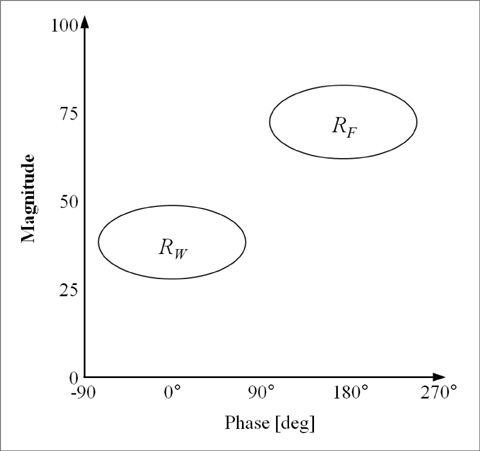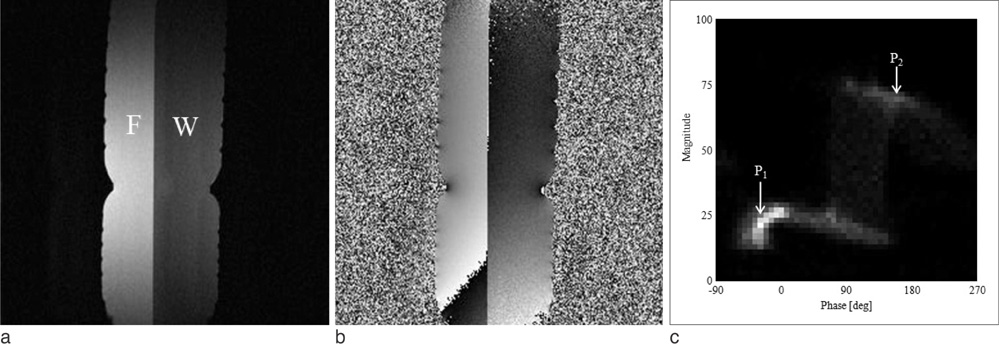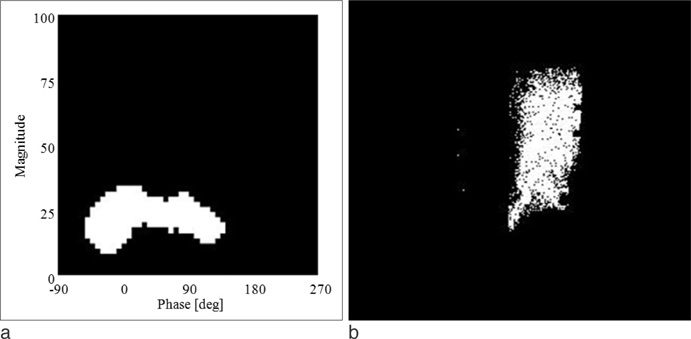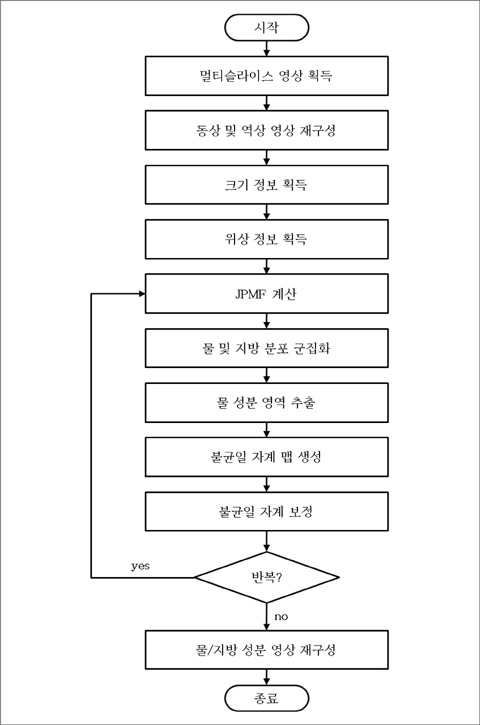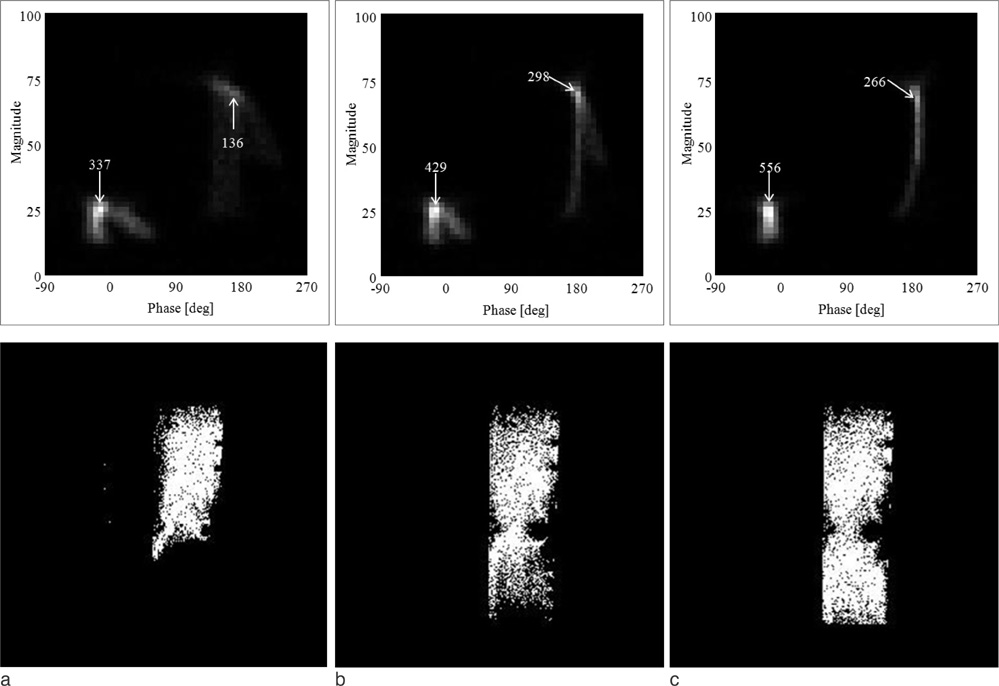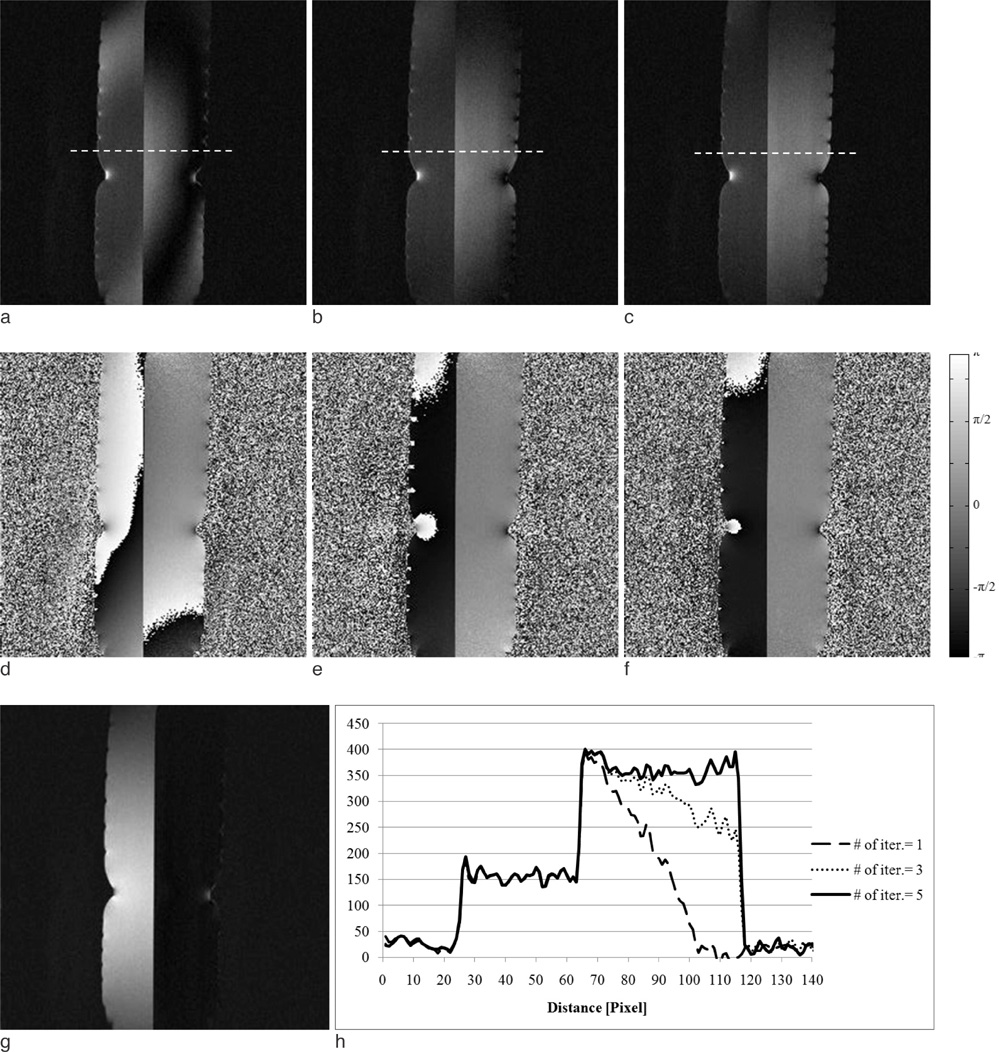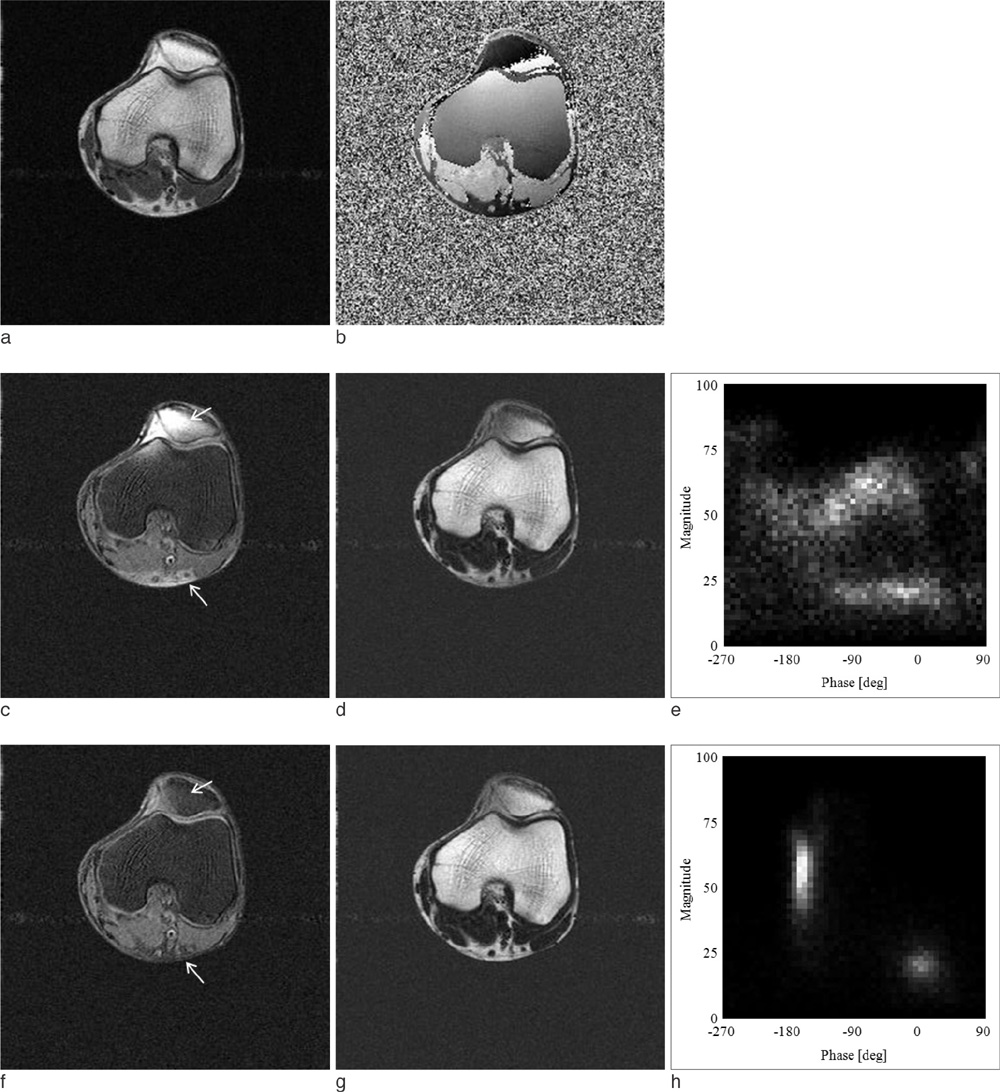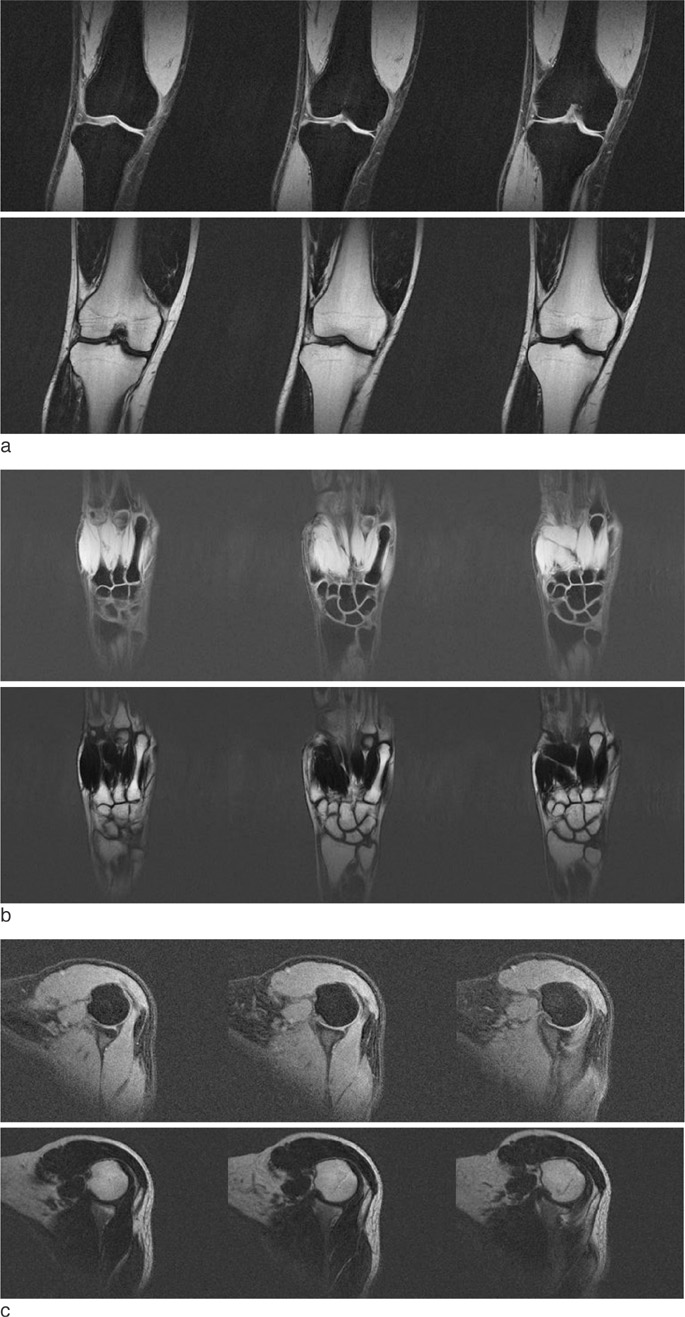J Korean Soc Magn Reson Med.
2011 Apr;15(1):57-66. 10.13104/jksmrm.2011.15.1.57.
Water-Fat Imaging with Automatic Field Inhomogeneity Correction Using Joint Phase Magnitude Density Function at Low Field MRI
- Affiliations
-
- 1Department of Electrical Engineering, Kwangwoon University, Korea. cbahn@kw.ac.kr
- KMID: 2041228
- DOI: http://doi.org/10.13104/jksmrm.2011.15.1.57
Abstract
- PURPOSE
A new inhomogeneity correction method based on two-point Dixon sequence is proposed to obtain water and fat images at 0.35T, low field magnetic resonance imaging (MRI) system.
MATERIALS AND METHODS
Joint phase-magnitude density function (JPMF) is obtained from the in-phase and out-of-phase images by the two-point Dixon method. The range of the water signal is adjusted from the JPMF, and 3D inhomogeneity map is obtained from the phase of corresponding water volume. The 3D inhomogeneity map is used to correct the inhomogeneity field iteratively.
RESULTS
The proposed water-fat imaging method was successfully applied to various organs. The proposed 3D inhomogeneity correction algorithm provides good performances in overall multi-slice images.
CONCLUSION
The proposed water-fat separation method using JPMF is robust to field inhomogeneity. Three dimensional inhomogeneity map and the iterative inhomogeneity correction algorithm improve water and fat imaging substantially.
Keyword
MeSH Terms
Figure
Reference
-
1. Emmanuelle M, Javier B, Glyn J, Jean R, Xavier M, Anne C. Fat suppression in MR imaging: techniques and pitfalls. Radiographics. 1999. 19:373–382.2. Hussain HK, Chenevert TL, Londy FJ, et al. Hepatic fat fraction: MR imaging for quantitative measurement and display-early experience. Radiology. 2005. 236:1048–1055.3. Guiu B, Petit JM, Loffroy R, et al. Quantification of liver fat content: comparison of triple-echo chemical shift gardient-echo imaging and in vivo proton MR spectroscopy. Radiology. 2009. 250:95–102.4. O'Regan DP, Callaghan MF, Wylezinska-Arridge M, et al. Liver fat content and T2*: simultaneous measurement by using breath-hold multiecho MR imaging at 3T-feasibility. Radiology. 2008. 247:550–557.5. Kellman P, Hernando D, Shah S, et al. Multiecho dixon fat and water separation method for detecting fibrofatty infiltration in the myocardium. Magn Reson Med. 2009. 61:215–221.6. Hu HH, Kim HW, Nayak KS, et al. Comparison of fat-water MRI and single-voxel MRS in the assessment of hepatic and pancreatic fat fractions in humans. Obesity. 2010. 18:841–847.7. Keller PJ, Hunter WW Jr, Schmalbrock P. Multisection fat-water imaging with chemical shift selection presaturation. Radiology. 1987. 164:539–541.8. Bydder GM, Young IR. MR imaging: clinical use of the inversion-recovery sequence. J Comput Assist Tomogr. 1985. 9:659–675.9. Dixon WT. Simple proton spectroscopic imaging. Radiology. 1984. 153:189–194.10. Glover GH, Schneider E. Three-point Dixon Technique for true water/fat decomposition with B0 inhomogeneity correction. Magn Reson Med. 1991. 18:371–383.11. Glover GH. Multipoint dixon technique for true water and fat proton and susceptibility imaging. J Magn Reson Imaging. 1991. 1:521–530.12. Skinner TE, Glover GH. An extended two-point Dixon algorithm for calculating separate water, fat, and B0 images. Magn Reson Med. 1997. 37:628–630.13. Coombs BD, Szumowski J, Coshow W. Two-points Dixon technique for water-fat signal decomposition with B0 inhomogeneity correction. Magn Reson Med. 1997. 38:884–889.14. Ghiglia DC, Pritt MD. Two-dimensional phase unwrapping: theory, algorithm, and software. 1998. New York: John Wiley & Sons.15. Ma J. Breath-hold water and fat imaging using a dual-echo two-point Dixon technique with an efficient and robust phase-correction algorithm. Magn Reson Med. 2004. 52:415–419.16. Schmidt MA, Fraser KM. Two-point Dixon fat-water separation: improving reliability and accuracy in phase correction algorithm. JMRI. 2008. 27:1122–1129.17. Pruessmann KP, et al. SENSE: sensitivity encoding for fast MRI. Magn Reson Med. 1999. 42:952–962.18. Ahn CB, Jo JM, Cho ZH. Magnetic field homogeneity correction algorithm using pseudoinversion formula for NMR imaging. Rev Sci Instrum. 1986. 57(4):683–688.19. Irarrazabal P, Meyer CH, Nishimura DG, Macovski A. Inhomogeneity correction using an estimated linear field map. Magn Reson Med. 1996. 35:278–282.20. Bernstein MA, King KF, Zhou XJ. Handbook of MRI Pulse Sequence. 2004. New York: Elsevier.21. Reeder SB, Wen Z, Yu H, et al. Multicoil Dixon chemical species separation with an iterative least-squares estimation method. Magn Reson Med. 2004. 51:35–45.
- Full Text Links
- Actions
-
Cited
- CITED
-
- Close
- Share
- Similar articles
-
- Simultaneous Unwrapping Phase and Error Recovery from Inhomogeneity (SUPER) for Quantitative Susceptibility Mapping of the Human Brain
- Higher Order Shimming for Ultra-fast Spiral-Scan Imaging at 3 Tesla MRI System
- Background Gradient Correction using Excitation Pulse Profile for Fat and T2* Quantification in 2D Multi-Slice Liver Imaging
- Estimation of Inhomogeneity Correction Factor in Small Field Dosimetry
- Treatment Planning Correction Using MRI in the Radiotherapy of Cervical Cancer

